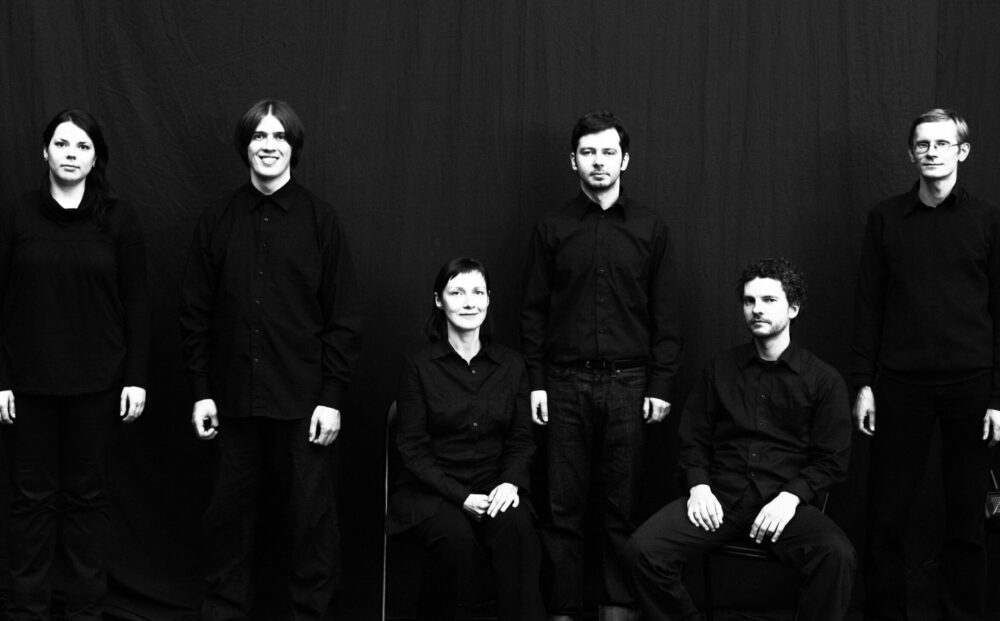
21:00
Taavi Kerikmäe (piano)
Levi-Danel Mägila (cello)
Tarmo Johannes (flute)
Merje Romere (violin)
Helena Tuuling (clarinet)
Featuring Adam Jeffrey (percussion)
Tammo Sumera (audio engineer)
Liina Sumera – Pororoca (2024, premiere) for cello and electronics
Justina Repečkaitė – Incantare (2018) for flute and electronics (version for bass flute: Tarmo Johannes, 2021)
Marianna Liik – Underground (2024, premiere) for flute, clarinet, percussion, piano, violin, cello and electronics
Mārtiņš Viļums – LUM (2004) for flute, violin and tape
Malle Maltis – Episode in Curved Spacetime (2024, premiere) for clarinet, percussion and electronics
Pororoca (2024, premiere) for cello and electronics. Liina Sumera: Pororoca is a natural tidal bore that forms during different lunar phases in the Amazon River in Brazil when water from the Atlantic Ocean thrusts its force into the river and makes it flow in the opposite direction. The wave can be as high as 4 metres and travel about 800 km. Pororoca destroys vegetation, large trees and even houses. The word ‘pororoca’ is thought to have derived from the language of the native Tupi people, where it might be translated as ‘a great destructive noise’ or ‘big roar’. The composition has been inspired by its more direct meaning – noise, swash and raw force.
Justina Repečkaitė: The title Incantare (2018) translates from Latin, in – ‘into’ + cantare ‘to sing’. In this composition, the flautist part is heavily charged with singing into the flute while playing. The electronics part is compiled of only one source: the composer’s voice of vocal fry, overtone singing, breaths, noises and whispers of charms repeating ‘Bird without a sting, tree without a trunk, water without legs’ (‘Paukštis be geluonies, medis be liemens, vanduo be kojų’ in Lithuanian). The flute both imitates and fights against the electronics part, thus creating charged dynamics. A video camera pursues the performer until the end of the composition when the flautist fights back and starts pursuing the cameraman.
Maaalune (Underground, 2024, premiere). Marianna Liik: the impulse for this piece came from the underground defence facilities in Tahkuna, Hiiumaa (an island off the coast of Estonia), where I have sometimes gone to record sounds as well. I am fascinated by the acoustic world where one can hear all sorts of sound reflections and mystical soundscapes without any electronics. Over there, no sound impulse remains unanswered. Reciprocal communication may develop in ways one could not have imagined.
Mārtiņš Viļums: Lum (2004) is an abbreviated version of the Latin words luminae naturae, meaning ‘enlightened nature’. The piece is composed of pre-recorded sounds of a block flute and violin. These were performed by myself as I searched for interesting articulations that could be aligned with my own musical aesthetics. While exploring sonocoloristic possibilities, I incorporated additional material from my earlier pieces, namely Koks. Uguns. Sirds (for Latvian kokles, flute, and accordion) and Simurg (for a large ensemble). It serves as a contemplation on the indirect sounds of nature, such as bird songs, gentle winds, reflections of rivers and lakes, and rustling leaves within the shadows of trees – all with a mystical light illuminating the phenomena of life.
Episode in Curved Spacetime (2024, premiere). Malle Maltis: As source material of the piece, I used the sounds produced by various falling objects. From a musical point of view, each sound of that falling, collision, breaking, bouncing, cracking, rolling has its unique rhythm and volume contour that is not controlled by the composer but instead shaped by randomness due to the gravity.
In Albert Einstein’s General Theory of Relativity, gravity is described as the curvature of spacetime caused by the uneven distribution of mass and energy. According to this theory, massive objects like stars and planets warp the fabric of spacetime, causing other objects to move along curved paths in response to this curvature. So, gravity is not a force in the traditional sense, but rather a consequence of the curvature of spacetime caused by mass and energy. Objects in free falling simply follow the curvature of spacetime, which we perceive as the force of gravity.
Tarmo Johannes: the concert of Ensemble U: offers a special opportunity to observe one’s own world and imagine the worlds of others at the Natural History Museum of the University of Tartu, where it might not become entirely clear who or what is observable, where is the observer and where is the exhibit. All the pieces in the programme are somehow connected with animate or inanimate nature.
Live-broadcast by Klassikaraadio. The concert is transferred across Europe through the EBU (European Broadcasting Union).